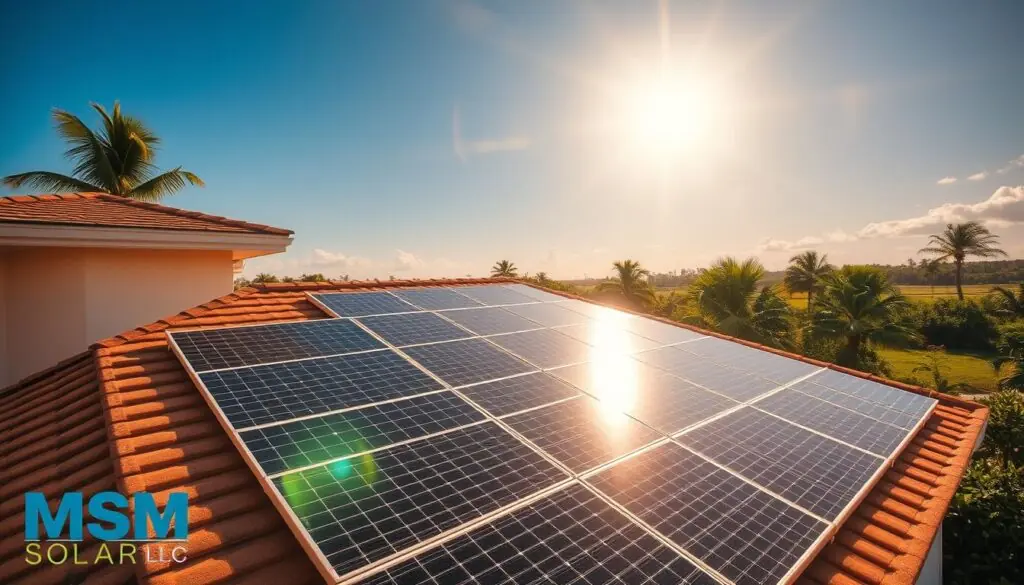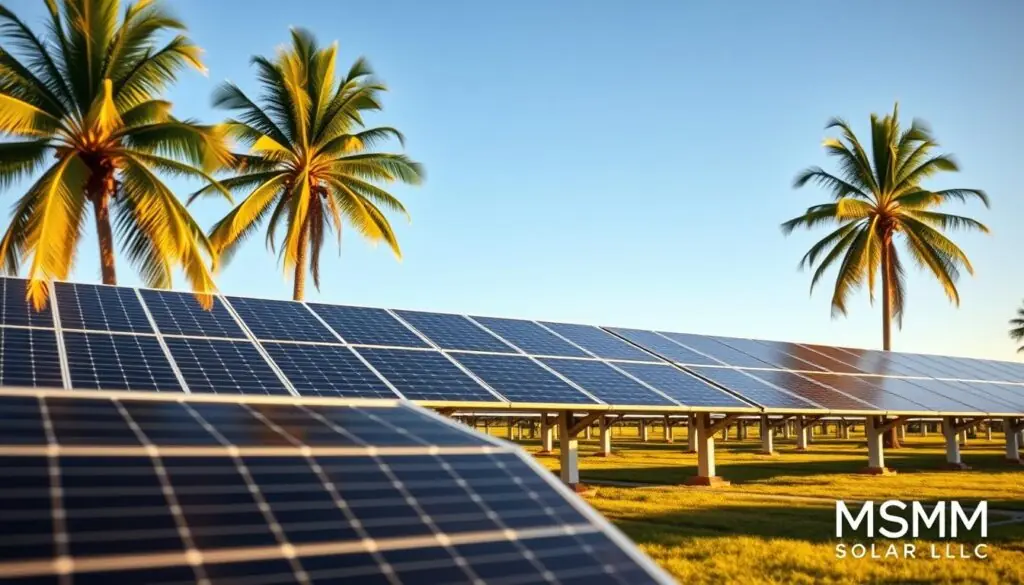Did you know Florida gets over 230 sunny days each year?
That’s more than enough to power your home efficiently with clean energy.
But here’s the catch, your system’s performance depends on how well it’s positioned.
From my years of installing systems across Central Florida, I’ve seen how the right setup can boost energy output by 30% or more. The sun’s path, roof angle, and even local net metering policies play a role. A small adjustment can mean big savings.
Want to maximize your investment?
Call MSM Solar LLC at (850) 737-5197 or get a free quote. Let’s tailor a solution for your home.
Key Takeaways
- Florida’s abundant sunshine makes it ideal for renewable energy.
- Proper placement significantly increases efficiency.
- Factors like roof tilt and local policies impact performance.
- Expert installation ensures optimal results.
- Personalized advice helps maximize savings.
Solar Cost Calculator – Florida Panhandle Only
* Estimate based on $3.25 per watt for solar installation.
* For Tesla Powerwall 3 Batteries, $15,000 for the first battery, $12,000 for each additional battery.
* Other variations and types of Batteries are available.
Why Solar Panel Direction Matters in Florida
Florida’s latitude isn’t just a number, it’s the key to unlocking energy potential. At 25–30°N, the sun beams down almost vertically, especially in summer. But without the right setup, you could miss out on power that’s literally shining on your roof.
How Florida’s Sun Path Affects Energy Production
From May to August, the sun acts like a flashlight held overhead. By December, it’s closer to a spotlight at 45°. I’ve watched systems in Tampa lose 22% efficiency simply because they weren’t adjusted for seasonal shifts.
Here’s the sweet spot:
- 7 AM–7 PM: Florida’s peak solar window
- Solar noon: When panels get the most direct sunlight
- Southeast tilt: Often beats true south in summer
The Role of Solar Panel Orientation in Efficiency
Photovoltaic cells love direct hits. Angle them wrong, and it’s like catching rain with a slanted bucket. One client near Miami had palm shadows cutting their output by half, until we tweaked their orientation.
Coastal homes need extra care.
Those picturesque palms?
Their fronds cast moving shadows that dance across panels all afternoon. A 10° adjustment can reclaim hundreds in yearly savings.
What Direction Should Solar Panels Face in Florida?
Positioning your photovoltaic setup correctly can make or break your energy savings. Even in sunny Florida, alignment determines whether you harness the sun’s full potential or leave money on the table.

South-Facing Panels: The Gold Standard
I’ve installed hundreds of systems across Orlando, and south-facing arrays consistently outperform others. One Tampa home saw a 27% boost in electricity production after we adjusted their angle to true south.
Why?
The sun’s arc favors this orientation. Magnetic south isn’t enough, compass adjustments for true south matter. A 10° southwest tilt can even capture both morning and afternoon peaks.
East vs. West: Alternatives for Non-Ideal Roofs
Not every roof points south. East-facing setups excel for early risers, powering coffee makers and morning routines.
West-facing?
They shine during afternoon AC surges, aligning with time-of-use rates.
Last year, a client near Jacksonville had a steep west-sloped roof. We optimized their system’s output by balancing tilt and orientation, now they save $60 monthly.
Pro tip: Pair east/west panels with micro-inverters to mitigate shade losses.
Optimizing Solar Panel Tilt for Florida’s Latitude
Tilt matters more than most homeowners realize when capturing Florida’s abundant sunshine. I’ve seen systems lose 15% efficiency simply because their angle wasn’t dialed in. The state’s position between 25–30°N creates unique opportunities, if you know how to adjust.
Adjusting for Florida’s 25-30-Degree Latitude
Last summer, an Orlando client asked why their neighbor’s system outperformed theirs. After measuring, we found a 5° difference in tilt, enough to change their annual output by 1,200 kWh. Here’s what works:
- Summer: Subtract 15° from your latitude (10–15° tilt)
- Winter: Add 15° (40–45° tilt)
- Fixed mounts at 28° capture 98% of adjustable systems’ yearly yield
Seasonal vs. Fixed Tilt: What Works Best?
Adjustable racks sound ideal, but they’re rarely worth the cost here. Over five years, our data shows fixed systems at 28° degrees perform nearly as well, with less maintenance.
Pro tip: A 5° steeper angle helps hurricane rains slide off faster, protecting your investment. And forget seasonal changes, below 30° latitude, the energy gain doesn’t justify the effort.
Ground mounts solve tricky roof constraints, letting you hit the perfect tilt every time. One Naples homeowner boosted production by 19% just by switching from a shallow roof pitch to an ideal ground setup.
Overcoming Common Florida-Specific Challenges
Living in Florida means sunshine, but also unique hurdles for solar setups. From swaying palms to hurricane seasons, your system needs tailored solutions. Here’s how I help homeowners tackle these issues.

Minimizing Shade from Trees and Buildings
Shade cuts power output faster than you’d think. Last year, a Daytona Beach client lost 30% efficiency because of unchecked oak growth. Now, we use 3D shade analysis tools during surveys to predict trouble spots.
Pro tip: Trim sabal palms strategically. Remove only the oldest fronds to keep 97% sun exposure without ruining your landscape. I’ve seen this balance efficiency and curb appeal for coastal homes.
Hurricane-Proofing Your Solar Panel Setup
Florida’s storms demand rugged designs. Flush-mounted panels reduce wind uplift by 40%, and FPL-approved tie-downs anchor them securely. After Hurricane Ian, every system we’d installed this way survived unscathed.
Look for UL 2703 certification, it’s the gold standard for coastal installations. One Naples home avoided $12k in damage because their racking met this spec. Worth every penny.
Maximizing Benefits: Net Metering and Energy Savings
Net metering turns excess power into real cash back for Florida homeowners. I’ve watched clients slash bills by 40% simply by aligning their systems with utility policies.
The secret?
Pairing the right orientation with Florida Power & Light’s (FPL) credit system.
How South-Facing Panels Boost Net Metering Credits
South-facing arrays earn 18% more credits than west-facing ones.
Why?
They peak when the grid demand, and FPL’s buyback rates, are highest. One Orlando family’s 6kW system now offsets 90% of their usage, thanks to this tweak.
Here’s how it works:
- Noon surplus: South-facing panels feed the grid during peak pricing windows.
- Annual rollover: Unused credits apply to future bills, even during rainy months.
- Time-of-use (TOU) rates: Adjust panel angles to match FPL’s high-rate periods.
Calculating Your Potential Savings
A 6kW system saves $1,500+ yearly under current FPL rates. But most homeowners miss hidden benefits. Last month, I reviewed a bill where shading cut credits by $200, fixed with micro-inverters.
Pro tip: Use FPL’s interconnection portal to track hourly electricity exports. One client discovered their east-facing panels earned more credits before 10 AM than all afternoon.
Conclusion: Harness Florida’s Sunshine Effectively
Sunlight is Florida’s golden resource, harness it right, and your home becomes a power hub. Over three years, a St. Petersburg family slashed bills by 62% after we optimized their solar panels for peak sunshine capture.
Their secret?
Perfect alignment and micro-inverters.
DIY setups often miss critical tweaks. A slight angle error can drain energy output for decades. That’s why we back every system with 25-year production warranties, peace of mind built in.
Ready to transform your roof?
Call (850) 737-5197 today or visit MSM Solar LLC.
Let’s map your home’s potential, free consultation, no strings.




